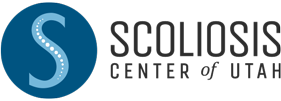Blogs
Scoliosis Pain in Hip: Causes, Symptoms, and Treatments
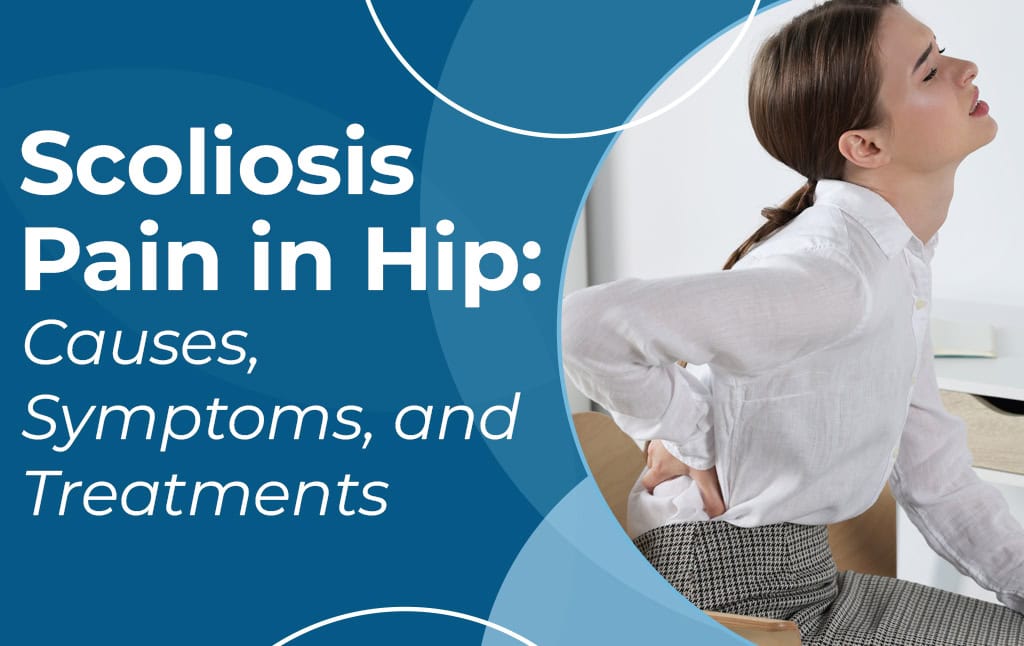
Scoliosis is a spinal condition that involves a loss of the spine’s healthy curves, but it doesn’t just affect the spine. A spine that’s not in a straight and neutral alignment can disrupt the body’s alignment from the head to the feet.
Scoliosis can cause hip pain by disrupting the natural alignment of the hips and pelvis which can cause uneven weight distribution, ligament laxity, joint dysfunction, and a muscular imbalance. The best treatment for scoliosis hip pain is to address the underlying cause: the spine’s misalignment.
Scoliosis disrupts the overall symmetry of the body and can cause a number of symptoms and effects.
The Uneven Forces of Scoliosis
Scoliosis causes the spine to bend unnaturally to the side, causing a loss of healthy spinal curves.
In addition to bending unnaturally to the side, a scoliotic spine will also twist unnaturally making it a 3-dimensional condition.
The spine’s healthy curves are key to its function, and the spine is curved in each of its main sections.
If the spine loses a single healthy curve, it responds by putting in unhealthy curves, and this can make the spine weak, rigid, and less able to handle mechanical stress incurred during movement and impact.
And as a progressive condition triggered by growth, condition-related hip pain can get worse as the size of the unnatural spinal curve is increasing, as are the condition’s uneven forces.
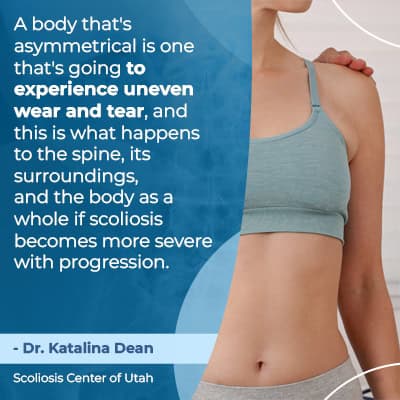 A body that’s asymmetrical is one that’s going to experience uneven wear and tear, and this is what happens to the spine, its surroundings, and the body as a whole if scoliosis becomes more severe with progression.
A body that’s asymmetrical is one that’s going to experience uneven wear and tear, and this is what happens to the spine, its surroundings, and the body as a whole if scoliosis becomes more severe with progression.
The ultimate goal of conservative treatment is to restore balance, alignment, and stability to the spine and body.
A spine that’s not aligned is introducing uneven forces to the body and can cause a number of effects, including hip pain.
Scoliosis Hip Pain
Not everyone with scoliosis will find the condition painful; in fact, scoliosis doesn’t become a compressive condition until growth has stopped.
In young patients who are still growing, the spine’s constant lengthening motion counteracts progression.
Once skeletal maturity has been reached, the unnatural lateral spinal curve causes compression of the spine, surrounding muscles, nerves, and can cause a number of effects.
So when it comes to scoliosis pain and scoliosis hip pain, this is more closely associated with adult scoliosis than childhood scoliosis.
Scoliosis hip pain can develop for a number of reasons, including uneven weight distribution due to postural changes.
Postural Changes
Postural changes are the main scoliosis symptom in children, and this is caused by the condition’s uneven forces disrupting the body’s symmetry.
Mild scoliosis will have mild effects that can be difficult to detect, and postural changes can be subtle. The more severe a condition is, the more likely it is to cause noticeable effects and be painful.
Many children with scoliosis are otherwise healthy, so if symptoms are subtle, it can be difficult to detect.
In many cases of childhood scoliosis, the earliest signs are uneven shoulders and uneven hips.
Uneven Weight Distribution
If the unnatural spinal curvature and rotation causes one hip to sit higher than the other, one hip is taking more weight than the other side; the hips aren’t aligned over the pelvis, and this causes uneven weight distribution over the lower body and can cause hip pain.
Uneven weight distribution over the hips and pelvis puts excessive strain on the muscles, ligaments, and tendons, and this can also change a person’s gait, balance, and coordination.
An uneconomical gait can develop that causes further uneven wear and tear on the lower body and the hip joints.
Strained Ligaments
Structural support is provided by strong muscles, tendons, and ligaments and are needed to stabilize the spine and pelvis.
Joint Strain
If the alignment of the hip joints is off balance, dysfunction of the hip joints can get worse and cause pain due to functional deficits.
Muscular Imbalance
Scoliosis is also associated with a muscular imbalance; the muscles on one side of the spine and body have to work harder to counteract the adverse spinal tension and uneven muscle use.
A facet of conservative scoliosis treatment focuses on restoring the spine’s surrounding muscle strength and balance.
Compressed Nerves
When scoliosis is compressive, it doesn’t just affect the spine and its surrounding muscles, but also the nerves within the spine.
If the nerves are compressed in the lower back and hips, radiating pain in the hips, along with numbness and weakness in the lower body are common effects.
Nerve and hip pain that affects the lower body is most closely associated with scoliosis that develops in the lumbar spine (lower back).
Scoliosis Hip Pain Treatment
Pain is a symptom of compressive scoliosis and can involve back pain, muscle pain, and pain that radiates into the extremities.
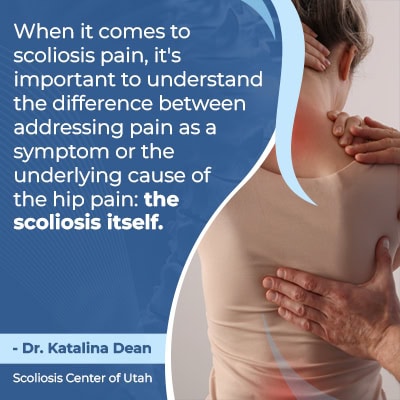 When it comes to scoliosis pain, it’s important to understand the difference between addressing pain as a symptom or the underlying cause of the hip pain: the scoliosis itself.
When it comes to scoliosis pain, it’s important to understand the difference between addressing pain as a symptom or the underlying cause of the hip pain: the scoliosis itself.
The underlying cause of scoliosis hip pain is the structural misalignment of the spine, so to improve hip pain for sustainable long-term results, proactive treatment that addresses the condition on multiple levels is key.
There are two main approaches to scoliosis treatment: traditional spinal fusion surgery and conservative non-surgical treatment.
Conservative Scoliosis Treatment
Here at the Scoliosis Center of Utah, we specialize in conservative non-surgical treatment with the goal of avoiding invasive spinal surgery by restoring balance and alignment to the spine, reducing the condition’s uneven forces and their effects on the rest of the body.
Conservative treatment is more successful when it’s started early; as a progressive condition that ranges from mild scoliosis to severe scoliosis, there are fewer limits to what nonsurgical treatment can achieve with early diagnosis and treatment.
There are no treatment guarantees, but proactive treatment should be started as soon as possible because as a progressive condition, scoliosis is likely to get worse and more complex to treat over time.
The Center’s approach combines multiple treatment disciplines for the best results: Chiropractic BioPhysics® (CBP), ScoliBalance® therapy, and scoliosis bracing for 3-dimensional approach to correction.
Chiropractic BioPhysics® is the combination of chiropractic care and a number of scientific disciplines: biology, physiology, geometry, and anatomy.
CBP can help identify the underlying cause of structural and joint-related pain to work towards restoring the spine’s alignment, balance, and stability, and these changes will be felt in the spine’s surroundings and areas of the body affected, such as the hips.
ScoliBalance® therapy can help reduce the size of the unnatural spinal curve and strengthen the spine’s surrounding muscles for more stability.
ScoliBalance® works with CBP to develop healthy posture so the spine’s healthy alignment can be supported.
Physical therapy involves a number of mirror-image exercises to teach postural awareness and remodeling so patients are aware of how to hold their spines and bodies during movement to help with correction.
A corrective ScoliBrace® is an important part of childhood scoliosis treatment because growing spines are more responsive, and the brace can be customized.
Conclusion
When it comes to scoliosis pain, there are different factors and severity levels that shape how painful a condition is, or isn’t.
Once scoliosis becomes compressive in adulthood, it can become painful, particularly if severe and/or if left untreated.
Patient age, condition type, severity, and where the scoliosis develops in the spine will shape a patient’s pain level.
Scoliosis hip pain can be caused by uneven weight distribution, strained ligaments, joint strain and dysfunction, muscular imbalance, and compressed nerves.
The underlying cause of the hip pain has to be addressed for any type of sustainable long-term pain relief.
If the scoliosis is addressed proactively, with a conservative treatment approach that’s individualized to address the specific curvature type and severity, invasive spinal surgery can be avoided, and balance and stability may be restored.
If the spine’s misalignment has disrupted the body’s overall symmetry, functional deficits can develop, and if progression occurs, condition-related hip pain can increase.
The best approach to addressing any type of scoliosis pain is to treat the condition itself, and as a structural condition, the abnormal curvature of the spine has to be reduced, restoring the spine’s healthy curves, and reducing the uneven forces being exposed to the body.
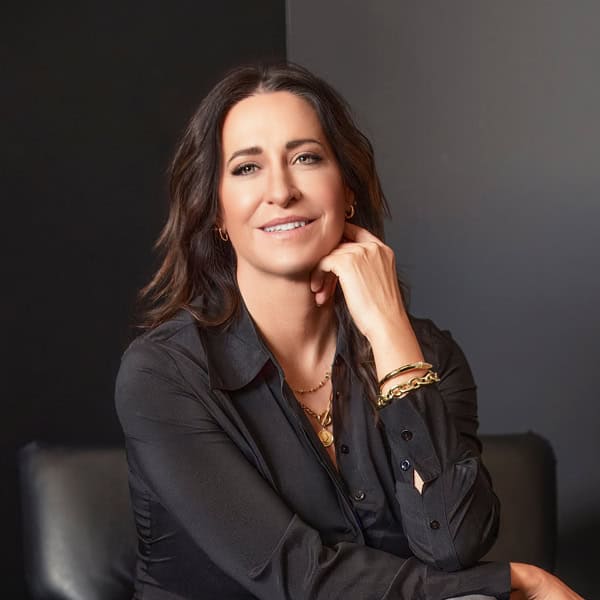
Dr. Katalina Dean
Dr. Katalina Dean is the founder and clinical director of Scoliosis Center of Utah, in Midvale, UT. Her team specializes in posture correction, spinal rehabilitation, and non-invasive scoliosis care and bracing.
Call Today
Do You Qualify for Care?
Schedule an Appointment Below
